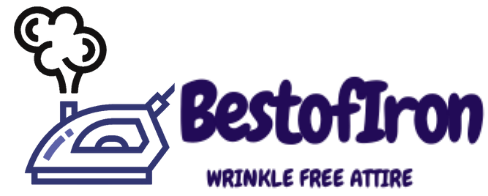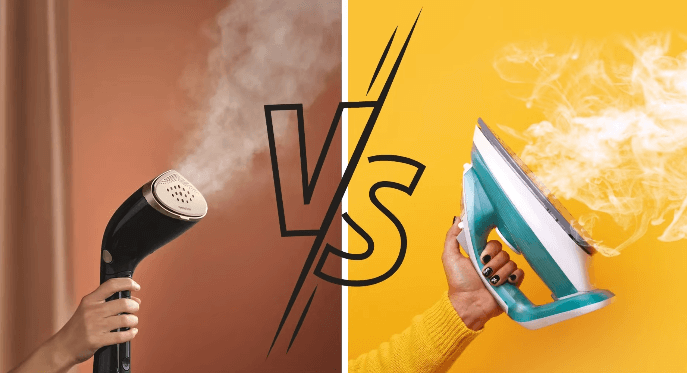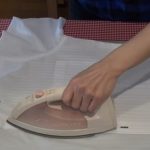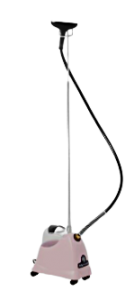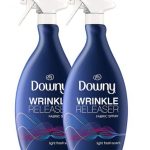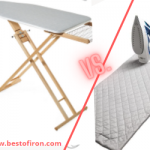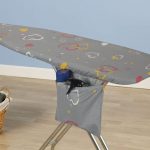The better choice to select between steaming vs. ironing depends on the fabric type. if you have plenty of time and the fabric material is thick, cotton or linen go for ironing otherwise for lighter and delicate fabric like silk, wool, and embellished clothes steaming is a better option.
The Main Difference between Steaming Vs. Ironing:
In This Article
The main difference between steaming vs. ironing is that steaming does not necessitate direct contact of the steamer with the fabric to remove creases, it works by producing high-power steam to lose the fabric and remove creases. Whereas, ironing always entails direct contact of the iron soleplate with the fabric to remove wrinkles by providing heat and pressure.
Moreover, ironing requires setting up the ironing board whereas, with a steamer, you can wrinkle out the dress in a hanging position.
Both steaming and ironing have their pros. Steaming is an ideal option for delicate fabrics and quick touch-ups. On the other hand, ironing is better for achieving a crisp look, especially on heavy fabrics that need sharper creases. In some cases, a combination of both ways might be the best approach to achieve the desired results.
Steamer vs. Steam Iron: Key Features to Consider
A steamer is used for steaming and a steam iron or steam generator is used for ironing clothes. Steaming and ironing are two standard methods used to remove wrinkles and freshen up clothes. Each method has its pros and cons. So the choice between the two depends on your preferences, the type of fabric, and the desired outcome.
1. Gentler on Fabrics:
Steaming is generally gentler on fabrics compared to ironing. Since there is no direct contact with the fabric, there is less chance of burning or harming delicate fabrics, making this method a safer option for keeping your favorite clothes. It is perfect for materials like silk, chiffon, and synthetic mixes that cannot resist the heat of an iron.
Whereas, ironing demands precision, requiring you to adjust the temperature according to the fabric’s care instructions. Some materials require high heat, while others call for a delicate touch. As little carelessness leads to damage to the clothes.
2. Quick and Convenient:
Steaming is often quicker and more convenient than ironing. It’s especially useful for removing wrinkles from hanging clothes, drapes, garments with embellished designs, and wedding dresses. Its simplicity makes it a user-friendly choice. A steamer simplifies the process. By hanging your garment on a hook, gently stretching it with one hand while using the other to glide the steamer vertically, section by section. This technique minimizes hassle while ensuring optimal results.
On the other hand, ironing is an art that requires mastering techniques to move and press the fabric effectively. Further, using an iron necessitates finding a flat, heat-resistant surface.
3. Minimal Upkeep Required:
Over time, irons can accumulate residue that may transfer onto your clothing, potentially causing damage. Frequently cleaning the iron’s plate to remove rust and hard water buildup becomes crucial to sustain its effectiveness. In contrast, steamers demand minimal maintenance, ensuring a hassle-free experience.
4. Convenience in Storage:
The compactness and ease of storage offered by handheld steamers are their standout features. This compact design also positions steamers as an ideal travel companion, ensuring wrinkle-free attire even in situations where ironing facilities are uncertain.
Unlike the bulkiness of an iron and ironing board, the handheld steamer occupies minimal space and can be conveniently stowed away.
5. Versatility beyond Clothes:
Steamers stand out for their versatility. Unlike irons, which are primarily designed for garment care, steamers offer a wider range of applications. Steaming not only removes wrinkles but can also help in killing bacteria and freshen up the fabric. In addition to refreshing curtains and furniture, steamers can sanitize fabrics and surfaces without the need for chemicals. They are also remarkably effective in achieving smudge-proof cleanliness for mirrors and windows.
An iron is not a versatile tool as a steamer but can be used not only for clothes but also for pressing linens, tablecloths, and other household items.
6. Professional Result and Different Fabrics:
For individuals with less formal dressing requirements, embellished or delicate fabrics, steamers prove to be a practical choice. Handling everyday creases and collars becomes a breeze with a steamer. Additionally, most fabrics respond well to steaming. However, steaming might struggle with heavy fabrics and stubborn wrinkles. It may not be as effective in these cases.
Ironing is more effective on thick fabrics and stubborn wrinkles. If you are looking for sharp creases and a crisp look, steaming might not be as effective as ironing. Ironing provides more accurate results, making it suitable for achieving sharp creases, pleats, and formal appearance.
7. Time-Consuming:
Ironing can be more time-consuming as compared to steaming, especially when dealing with large items like bed linens or curtains.
For items that are huge and can hung, use a steamer. It works faster and consumes energy.
Conclusion:
Finally, which one is a better choice for you, we conclude that it depends on your lifestyle and preferences. However, steamer use is simpler, needs low maintenance, is easy to use, and is multifunctional. So, a steamer emerges as a persuasive option for keeping your clothes wrinkle-free. So, the next time you encounter wrinkled attire, consider the handiness, versatility, and efficacy of a steamer.
However, for heavier fabrics like cotton or linen, sometimes you may need to iron to get the more stubborn wrinkles out.
